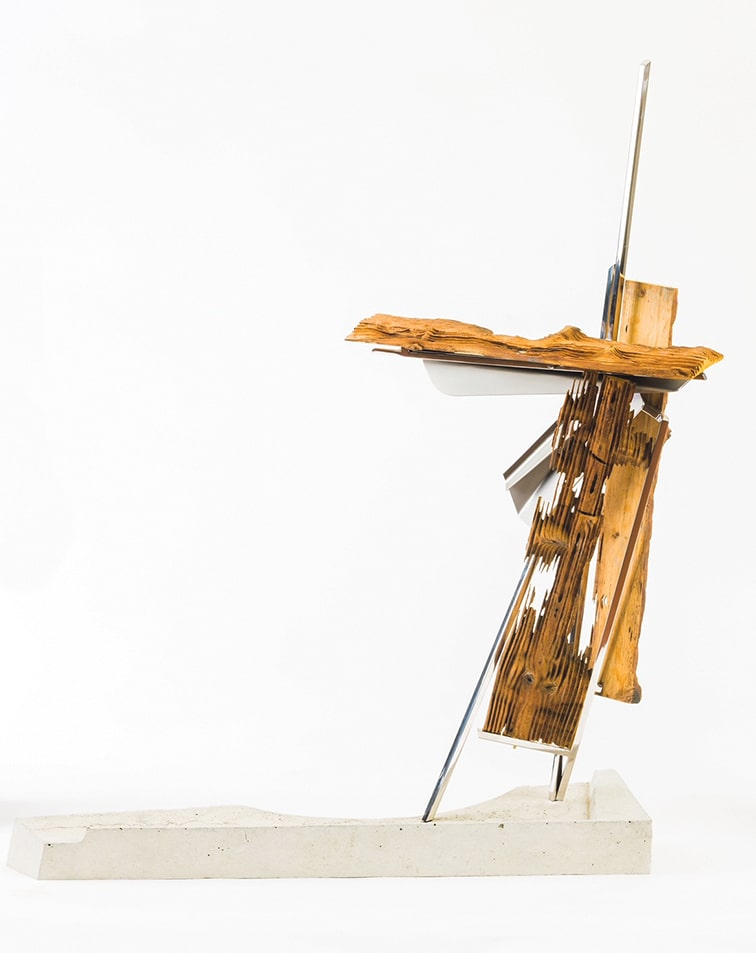
The shape of things
James Waller is an Australian born artist and poet based in West Cork. Through this column James explores the world of art, introducing the reader to major works of art and artists and reflecting on what makes them so engaging.
James offers a range of studio-based courses for children and adults in Classical painting, drawing and printmaking at Clonakilty School of Painting. See www.paintingschool.
jameswaller.org for details.
A slender line rises, like the bow of a double bass, up the tall sleek body of an object which, though reminiscent of a musical instrument, otherwise defies description. The material looks like beautifully shaped and polished timber, but it is in fact bronze. This is a sculpture titled ‘Trammelled,’ by Don Cronin, part of an exhibition of recent work, titled ‘Aculeate Compositions’ which showed in Gallery Asna, Clonakilty throughout October.

Like ‘Trammelled,’ the five works in ‘Aculeate Compositions’ defy expectations and assumptions. References to machine parts and instruments are sublimated into compositions which hover ever so softly beyond our comprehension: what looks like wood turns out to be bronze or fibre glass; what reminds one momentarily of an automotive chassis morphs and slips into something we can’t describe.
Cronin’s work is fresh, unusual and engineered to perfection. It leaves one mystified by a combination of its compelling unity and its stubborn non-referentiality. As associative beings we instinctively seek to associate one thing with another; if we hear an unfamiliar word we automatically reach for a word we know that sounds most like it. Confronted by Cronin’s polished monuments to modernity we are suspended in unfamiliar space; the few forms we fleetingly recognise are, in the end, of little help in understanding the broader language.
The broader language is what I would call Platonic abstraction. It is concerned with composition itself; Platonically removed from both the highs and lows of expressionism and the clever conceit of conceptualism, Cronin engages in the pure mystery of arrangement, bonding ever diverse materials and elements with a mastery rarely equaled. As the mystery of arrangement is the crux of Cronin’s art we would do well to reflect on what composition is and its place in art practice.
Some years ago I came up with the following formula: Composition is the Source, Vibration is the Spirit, and Illusion is the Dream. Extrapolating this further: The source of all power is composition, the spirit of all expression is vibration, and the dream of all reality is illusion. Without composition there is no art; it is the mysterious essence of art, its’ ground and being. Something composed well, but with low vibration or expression, and no illusory form can still be compelling as art (think of Piet Mondrian). Something with a higher level of expression or vibration, but poorly composed, falls apart and is quickly forgotten; well composed, however, it becomes immortal (think of Jackson Pollock in painting, or on a more subtle level, Alexander Calder in sculpture). A skilful illusion, well composed, but with low vibration or expression, will endure (think of Canaletto); if it is poorly composed, however, it will also be forgotten.
Artistic expression can be subtle, of course, and materials also have their own energetic qualities; this is where Don Cronin’s work straddles both composition and vibration; in doing so, however, it remains Platonic; that is, no emotional expression comes into play. Such a level of austere removal can be alienating, but also liberating; it is a realm of mysterious play where the most poetic combinations of form and material can breathe their own non-verbal meaning. Such is the case with my personal favourite from this show, which gives the exhibition its name: ‘Aculeate Composition.’ It is a comparatively small piece, made of segments of wood, sandblasted into skeletal ribs of wood fibre, held in a composition of steel. The combination of natural material and its attendant fragility with the strength of steel and its promise of space-age endurance, give this work a wonderful poignancy. It points to the poetic subtlety of Cronin’s practice, and to the (paradoxically) emotive potential of materials in themselves.
According to the Merriam Webster dictionary ‘aculeate’ is an adjective “relating to or being hymenopterans (such as bees, ants and wasps) of a division (Aculeata) typically having the ovipositor modified into a stinger.” In ‘Aculeate Composition’ sharp points ascend like violin bows (like in the work, ’Trammelled’), and the stance of the sculpture on its plinth reads like a conductor of an orchestra in mid-flight. That is just my association, of course. The ‘stinger’ in Cronin’s forms, when evident, is a lightning rod, a line of ascendency providing slender movement and a sense of speed as a counter-point to the solid mass it arises from. In this sense each sculpture seeks flight, even as it is earth-bound.
Cronin’s work is a lyrical argument for composition as the basis of art and a powerful riposte to the hollow pickings of conceptualism which hubristically claim the intellectual ground. For there is, I believe, nothing more intellectually sophisticated than the mystery of arrangement itself; how it unlocks a sense of the eternal within us, how it connects us beyond our conscious understanding.


